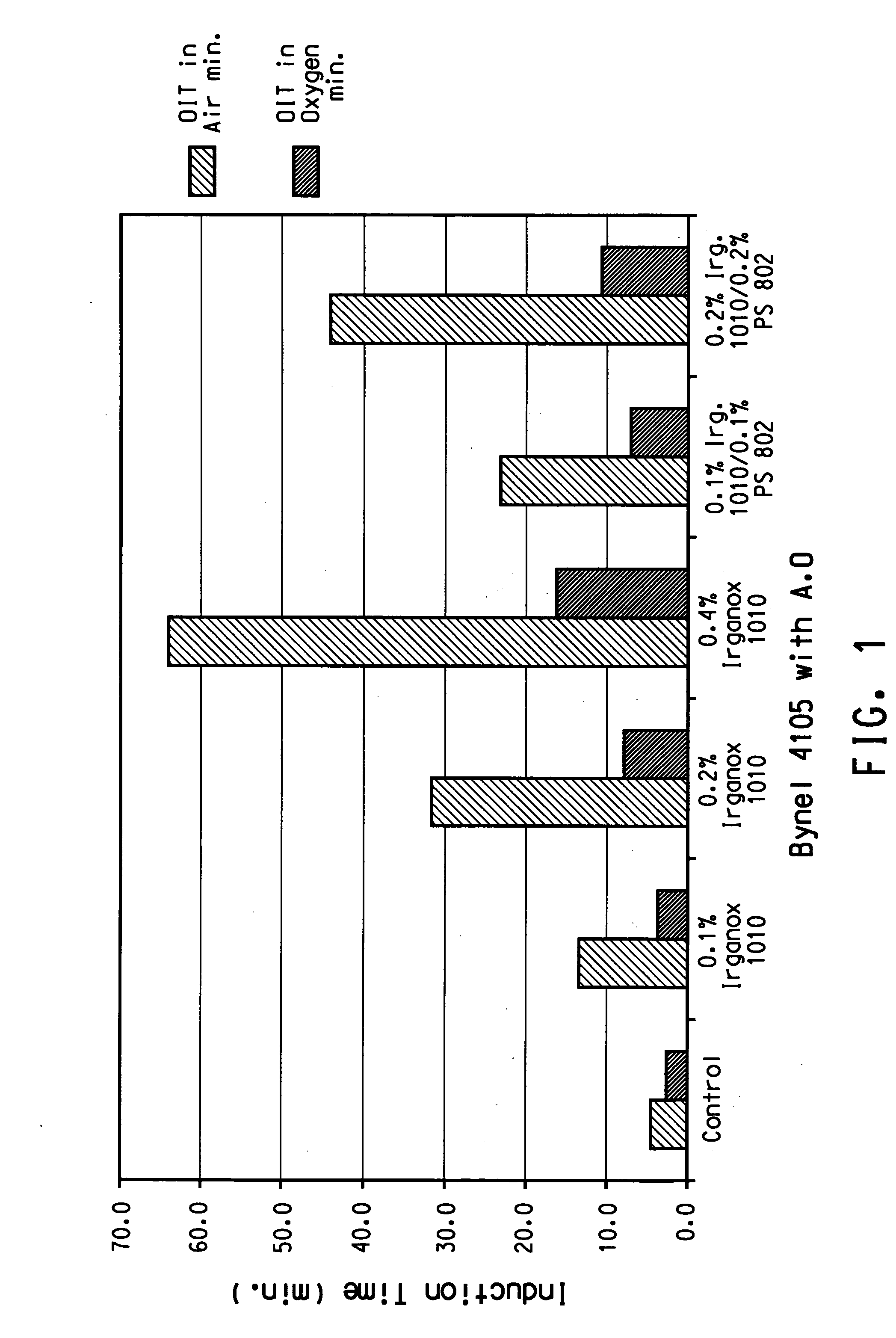Novel sealant material for electrochemical cell components
a cell component and sealant technology, applied in the field of new sealant materials, can solve the problems of gaskets or seals made of these materials being subjected to prolonged deformation, harsh operating environment, and gaskets or seals tending to decrease in resilien
- Summary
- Abstract
- Description
- Claims
- Application Information
AI Technical Summary
Benefits of technology
Problems solved by technology
Method used
Image
Examples
example 1
[0054] Two antioxidants namely, Irganox 1010 and Irganox PS802 were blended with Bynel 4105 according to general compounding and film casting procedure outlined before. Samples were measured for oxidative stability using Oxygen Induction Time (“OIT”) test (ASTM D3895-98) at the conditions described below:
Conditions:
[0055] Temperature: 220° C. [0056] Atmosphere: Both Air and Oxygen [0057] Equilibrate at 220° C. (in nitrogen), isothermal for 5 min, switch purge gas to air / oxygen. [0058] Results are shown graphically below:
[0059] As FIG. 1 illustrates, there is strong correlation between antioxidant content and OIT results. In both air and oxygen. Irganox 1010 appears more effective in wt % basis than Irganox PS 802. It should be noted however is Irgonox PS 802 is claimed to be more effective upon exposure to hydrolytic conditions.
example 2
[0060] The strength of sealing materials were tested by joining two manufactured parts (composite plaques) comprising 25% Zenite®, 55% Thermocarb® graphite powder and 20% graphite fibre. The parts had a length of 50 mm, width of 15 mm and a thickness of 2.5 mm.
[0061] A thin film of the sealing material, with a thickness of 6 mils (0.152 mm) was placed between two composite plate parts and the sandwiched assembly was placed in a hot press preheated at 170° C. The assembly was heated for 2 minutes without applying any pressure to it. After 2 minutes of heating the pressure was raised to 3 Mpa and the assembly was held under this pressure for another 2 minutes. After this the assembly was held under the pressure of 3 MPa and cooled to 70° C. Once cooled, the pressure was removed and the joined assembly was removed from the hot press.
[0062] The strength of the welded joint was measured and tabulated in
TABLE 1PolymerSeal Strength (MPa)Profax ® SB8230.564PRIEX ® 632080.967Fusabond ® 5...
example 3
[0064] Two composite parts comprising 25% Zenite®, 55% Thermocarb® graphite powder and 20% graphite fibre were welded using the resistance welding process. The parts each had a length of 50 mm, a width of 15 mm and a thickness of 2.5 mm.
[0065] A jig was made to apply a direct current through two electrodes attached directly to each part. A welding machine was used as a power source. The jig also applied and controlled the pressure on the composite parts. A gas cylinder was used as the source of pressure.
[0066] A thin film of the sealing material, with a thickness of 6 mils (0.152 mm) was placed between two composite plate parts and the sandwiched assembly was placed in the jig and a 55-ampere (55 A) current was passed through the parts for approximately 30 seconds. 3 MPa pressure was applied to the plates during the joining process. Good sealing was obtained for Bynel® 4105, Profax® SB823, Fusabond® 511 D and PRIEX® 11006 sealing materials.
PUM
| Property | Measurement | Unit |
|---|---|---|
| density | aaaaa | aaaaa |
| density | aaaaa | aaaaa |
| diameter | aaaaa | aaaaa |
Abstract
Description
Claims
Application Information
 Login to View More
Login to View More - R&D
- Intellectual Property
- Life Sciences
- Materials
- Tech Scout
- Unparalleled Data Quality
- Higher Quality Content
- 60% Fewer Hallucinations
Browse by: Latest US Patents, China's latest patents, Technical Efficacy Thesaurus, Application Domain, Technology Topic, Popular Technical Reports.
© 2025 PatSnap. All rights reserved.Legal|Privacy policy|Modern Slavery Act Transparency Statement|Sitemap|About US| Contact US: help@patsnap.com

